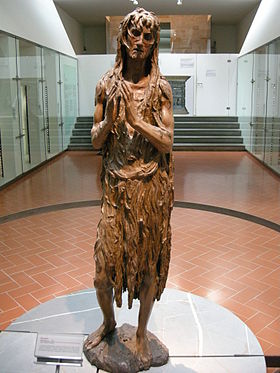Penitent Magdalene (Donatello)
| Magdalene Penitent | |
|---|---|
 | |
| Artist | Donatello |
| Year | 1453-1455 |
| Type | Wood |
| Dimensions | 188 cm |
| Location | Museo dell'Opera del Duomo, Florence |
The Penitent Magdalene is a wooden sculpture of Mary Magdalene by the Italian Renaissance sculptor Donatello, created around 1453-1455. The sculpture was probably commissioned for the Baptistery of Florence. The piece was received with astonishment for its unprecedented realism. It is currently housed in the Museo dell'Opera del Duomo in Florence.
The wood used by Donatello is that of White poplar.
Iconography
Though the "Penitent Magdalene" was the usual depiction for the many single figures of Mary Magdalene in art, Donatello's gaunt, emaciated figure differs greatly from most depictions, which show a beautiful young woman in nearly perfect health. The Magdalene Penitent is famous for the detailed and very realistic carvings on the statue. Medieval hagiography in the Western church had conflated the figure of Mary Magdalene, already conflated with Mary of Bethany and the unnamed sinner in the Anointing of Jesus, with that of Saint Mary of Egypt. She was a popular figure in the Eastern church, who had been a prostitute before spending thirty years repenting in the desert. Donatello's depiction is similar to, and very probably influenced by, Eastern Orthodox icons of Mary of Egypt, which show a similar emaciated figure. He thus ignored the Western legends by which Mary was daily fed by angels in the desert.
History
Documentation about the work is scarce. The Renaissance art historian Giorgio Vasari mentions it as work with no flaws and a perfect anatomy. Executed by Donatello when he was more than sixty years old, after he had spent a decade in Padua. The dating has been established indirectly, basing on that of a copy from Neri di Bicci's workshop (now in the Museum of the Collegiate of Empoli), known to be from 1455.
In 1500 it was in the city's baptistery. According to an Italian historian, it was seen by Charles VIII of France in the 1480s, when he was camped with his army near Florence.
The work was damaged by the 1966 flood of the Arno River. A program of restoration was finished in 1972. At the time that restoration was begun, the work was painted dull brown. A restorer, beginning the restoration, while washing the feet of the Maddalena, discovered a tiny golden patch. The restoration work thus included removal of all the darkness which had been applied at some negative time in history.
Sources
- Cavazzini, Laura (2005). Donatello. Rome: Gruppo Editoriale L'Espresso.
